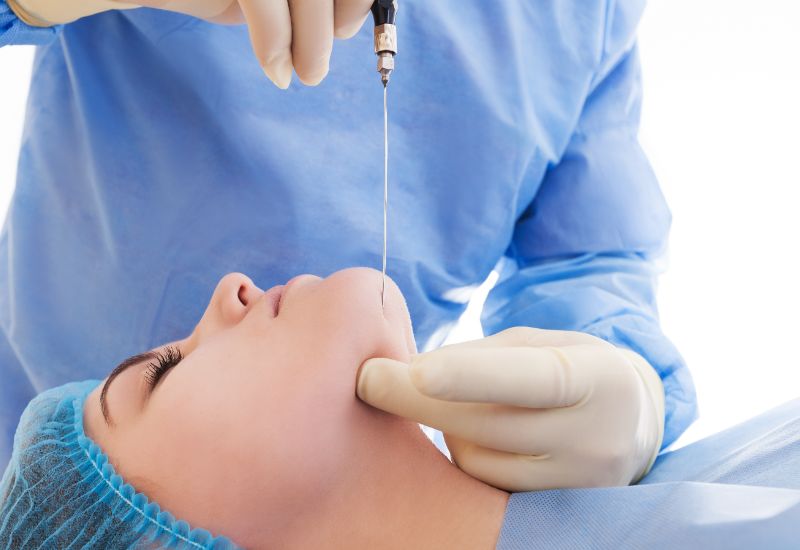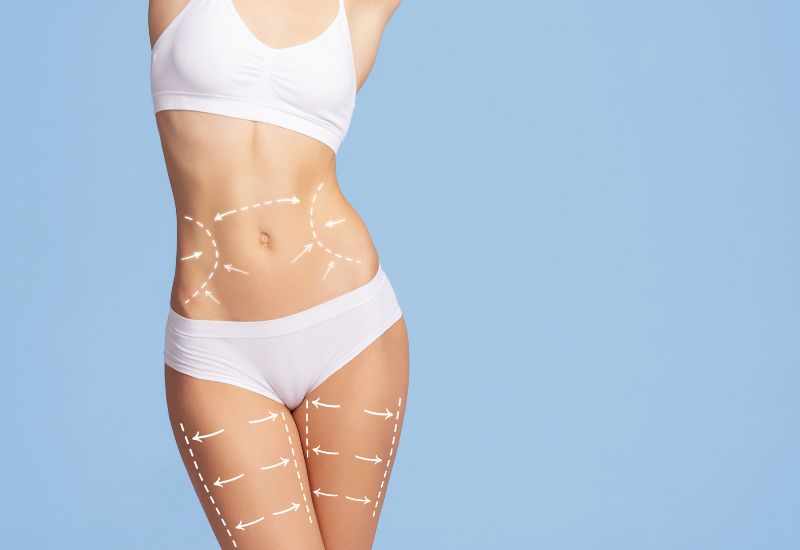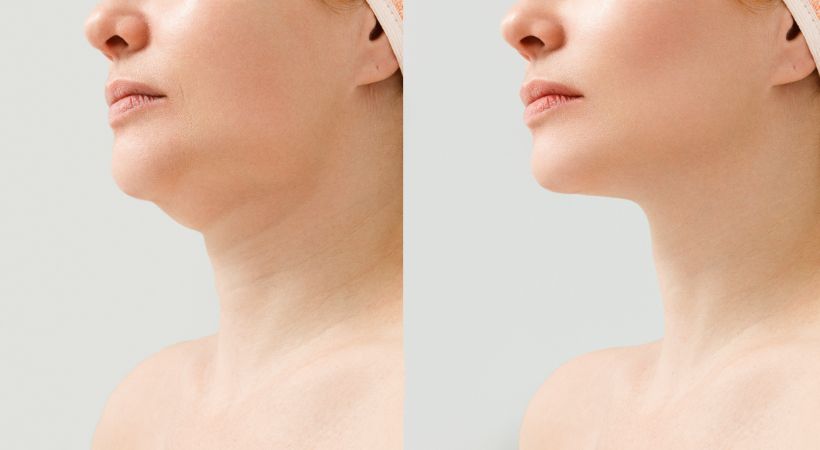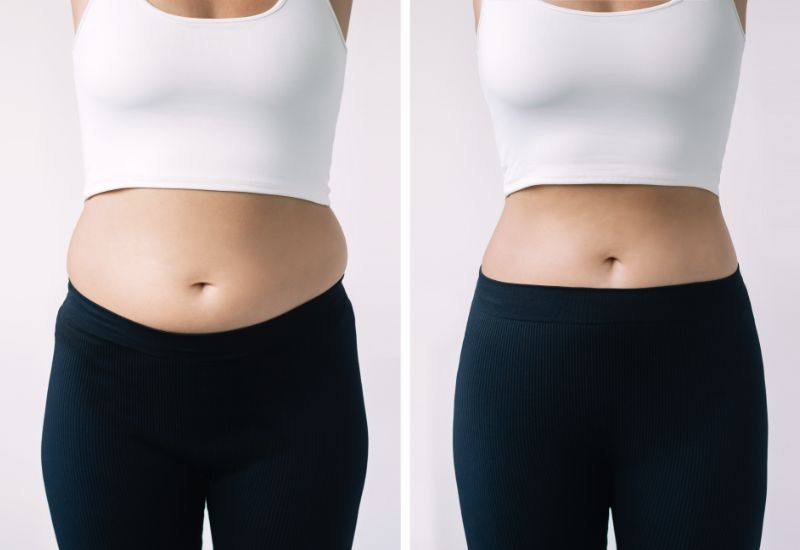Going through any sort of operation will require a certain amount of recovery time.
Cosmetic operations are no different.
Just like most medical procedures, cosmetic surgery can involve going under local or general anaesthesia. Then the body will be subject to some sort of trauma e.g. incisions.
Your body will gradually go through the recovery process, so this must happen naturally and undisturbed.
In this guide, we will focus on the recovery process when you experience a liposuction procedure.

The Liposuction Recovery Timeline
The healing time after liposuction surgery can vary from person to person, but here is a general guide to the stages of recovery.
It’s important to note that individual experiences may differ, and it’s crucial to follow your surgeon’s specific instructions.
Immediate Postoperative Period
As the procedure requires rigorous movements, surgeons will usually perform liposuction under general anaesthesia.
However, this will depend on how much fat you’re getting removed.
If it’s a large area, then general anaesthesia will be required.
For smaller areas, you may only need local anaesthesia which will play a role in the duration you stay in the hospital as you will need to wait for the anaesthetic to wear off. The more anaesthetic used the longer you will need to wait for it to wear off.
How Long Do You Stay In Hospital After Liposuction
After the surgery, you will spend some time in the recovery room where medical staff will monitor your vital signs.
The length of your stay in the recovery room will all depend on how your surgery went.
If there were any complications or there was a large amount of fat to be removed then you’ll likely stay overnight and be monitored.
If this is not the case then you’ll likely be discharged on the same day. However, you will still need transportation facility to and from the surgery.
Other factors to be considered for the length of stay in hospital are:
Type of Anaesthesia: Patients may be released the same day after receiving local anaesthesia for mild liposuction. A prolonged observation period is frequently necessary for procedures carried out under general anaesthesia in order to guarantee anaesthesia recovery.
Health Condition: Long-term monitoring may be necessary for patients with chronic disorders (such as diabetes, high blood pressure, or cardiac issues). On the other hand, patients that are in better health condition have faster healing time.
Type of Surgery: Different surgeries like, tumescent liposuction, vaser liposuction, or the traditional form of liposuction may have different recovery time. More intrusive processes may have longer healing time.
Post-Operation Check: Extended hospitalisation may be necessary for problems such severe bleeding, fluid imbalances, or infection.

Degree of Pain: Patient should not be in constant pain for them to be discharged. If patients need pain relieving injections at frequent intervals, they are advised to stay longer in the hospital.
Help Available: The time to discharge may also be decided based on the help and support available for the patient at home. It also depends on how long do you have to travel to your place from hospital.
You’ll also be provided with compression garments to wear.
These garments help reduce swelling, promote blood circulation, and support you during the healing time.
A study was carried out in 1989 which showed that patients who wore compression garments after surgery for 3-8 weeks achieved optimal skin outcomes while still minimising postoperative edema.
First Few Days
Rest is crucial during the first few days of the liposuction healing process due to the trauma inflicted on your body.
It’s important to follow your surgeon’s advice on how much rest is needed and avoid strenuous activities.
Postoperative wound infection can happen anytime after surgery, especially after the first few days, so it’s important not to push yourself and risk the wound being compromised.
You may experience some pain and discomfort, which can be managed with prescribed pain medications.
Your surgeon will have strict instructions for how much of and how frequently you should be taking this medication.
Swelling and bruising are common after liposuction.
The colour of the bruising may range from deep purple to a greenish-yellow colour.
This is a normal sign of the body’s natural recovery process taking place.
Applying cold compression and keeping the area elevated can help minimise these effects.
First Two Weeks
Swelling typically starts to subside during the second week, but you may still have some residual swelling.
Depending on your progress, your surgeon may allow you to gradually resume light activities, but you should still avoid strenuous exercise.
You may still need to wear compression garments during the second week, but your surgeon will provide guidance on when and how to transition out of them.
After these first two weeks of recovery time, most people can make a return to work depending on the type of work you do.
If your work is a physically demanding job then you may want to book additional time off to ensure a full recovery.

Weeks 3-6
By this time, you may be able to resume most normal activities.
However, you will need to consult with your surgeon before engaging in any vigorous exercises.
If there are incisions, follow any scar care instructions provided by your surgeon. This may include applying ointments or avoiding sun exposure.
Pay attention to the changes in your body contour and keep in mind that the final results may take several months to become fully apparent.
How Long Do You Have to Wear a Body Shaper After Liposuction?
The duration for wearing a body shaper after liposuction varies depending on your healing progress and the recommendations of your surgeon.
In general, you’re often advised to wear a compression garment consistently for the first few weeks following liposuction.
This initial healing time is crucial for minimising swelling, promoting proper contouring, and supporting lipo recovery.
Typically, patients may wear the compression garment full-time for the first few weeks and gradually transition to part-time use over the next several weeks.
It’s essential for you to follow your surgeon’s specific guidelines when it comes to compression garments.
Adherence to post-operative instructions from your surgeon plays a vital role in achieving optimal results and a smooth recovery after liposuction.
How Long Does It Take Skin to Tighten After Liposuction?

The timeline for skin to return to normal after liposuction varies among individuals and depends on factors such as skin elasticity, the extent of the liposuction procedure, and overall health.
In general, it may take several weeks to a few months for the initial swelling and bruising to subside.
The full resolution of swelling and the final appearance of the skin contour may take several months to a year.
Skin can adapt and tighten over time, and factors such as age, genetics, and the quality of skin elasticity play a role in this process.
Tips for liposuction Healing Process
Here are our tips to follow for optimal lipo recovery:
Stay Hydrated
Hydration plays a significant role in supporting the body’s natural healing mechanisms.
Proper hydration helps maintain optimal blood circulation, facilitating the efficient transport of nutrients and oxygen to the treated areas, which is essential for tissue repair.
Staying hydrated aids in the elimination of toxins and reduces the risk of complications.
Swelling is a common side effect of liposuction, and staying well-hydrated can help manage this by promoting a healthy fluid balance within the body.
Hydration also contributes to skin elasticity, which is particularly important as the skin adjusts to its new contours post-surgery.
A study in 2014 showed that patients reported a higher satisfaction level and experienced less discomfort when hydrated during surgery recovery.
Avoid Smoking
Smoking has adverse effects on the circulatory system, leading to reduced blood flow and oxygen delivery to tissues.
This compromised blood circulation can impede the body’s ability to heal efficiently, increasing the risk of complications such as delayed wound healing and infection.
One of the cigarette’s main components, nicotine, constricts blood vessels, which further diminishes the blood supply to your wound.
Smoking also introduces harmful chemicals into the body, hindering the natural healing process and potentially compromising the final aesthetic results of the procedure.
Studies have shown slower healing in smokers with wounds resulting from trauma, disease, or surgical procedures. Therefore, it should be avoided during recovery time.

Follow Instructions
Your surgeon tailors these guidelines based on the specific details of your procedure and individual needs.
Following instructions regarding medication schedules, wound care, and activity limitations is essential for managing pain, minimising the risk of infection, and ensuring proper healing after liposuction.
Each instruction your surgeon gives is designed to optimise the healing process, promote the desired aesthetic outcome, and reduce the risk of complications.
By following your surgeon’s guidance it can contribute significantly to the success of your liposuction surgery and the overall satisfaction with the results.
Exercise and Healthy Lifestyle
Gradually reintroducing exercise in consultation with your surgeon can enhance circulation and promote overall well-being.
Engaging in light aerobic activities and strength training can aid in restoring muscle tone and flexibility.
A balanced and nutritious diet is crucial for providing the body with essential nutrients needed for optimal healing and recovery.
Exercise and a healthy lifestyle contribute to weight management, helping to maintain the results achieved through liposuction.
Studies have shown the benefits of proper nutrition after surgery and how it can help support recovery.
Follow-up visits
Attending follow-up visits that are scheduled by your surgeon are vital for recovery.
These sessions allow your surgeon to assess the progress of your recovery from liposuction.
If there are any complications or setbacks then your surgeon can spot these easily if you attend the follow-up sessions.
As you attend each session you’ll be able to ask any questions that you may have about your recovery journey.

Patience
Going through liposuction surgery can take its toll on your body.
For this reason, you must be patient during the recovery process. Understand that everyone’s healing journey is different.
Learn to take each day as it comes and don’t try and wish your recovery to be over, otherwise, it will feel longer than it has to.
Instead, learn to see the positives in seeing you progress through your recovery week by week. You’ll start to associate more positive feelings with your journey to full recovery.
Liposuction Recovery with New Birkdale Clinic
As mentioned, every individual’s recovery journey is unique.
This is why it’s important to always follow the advice of your surgeon as they will know and understand your particular recovery process better than anyone else.
At New Birkdale Clinic, we help you make a full recovery when you choose one of our liposuction treatments.
Our world-class surgeons are there to guide you every step of the way along your recovery journey.
Contact us today and let’s get your liposuction journey started.
